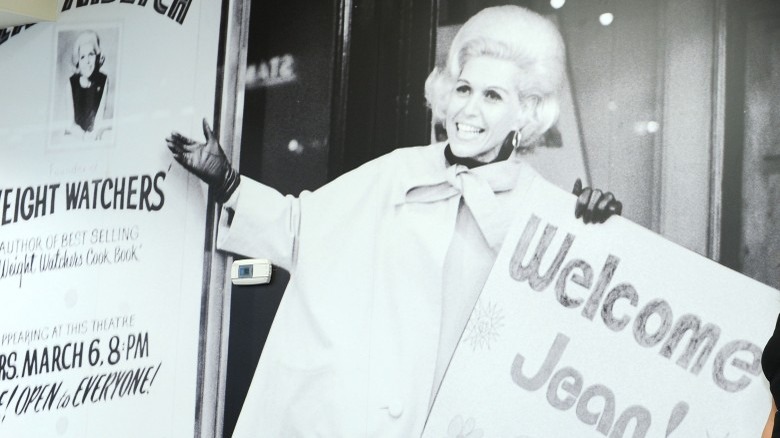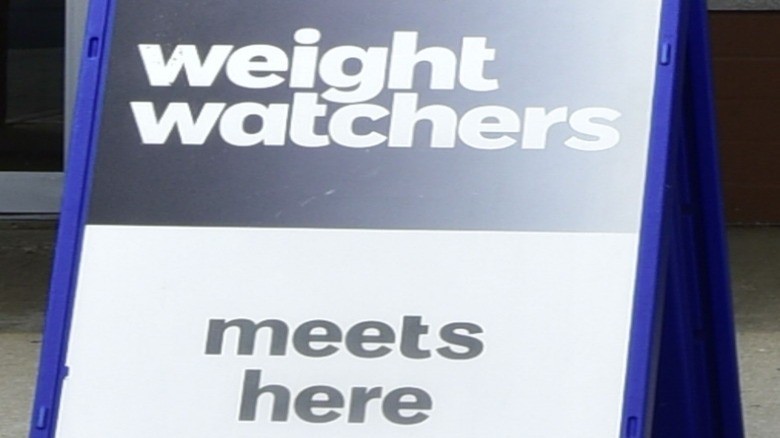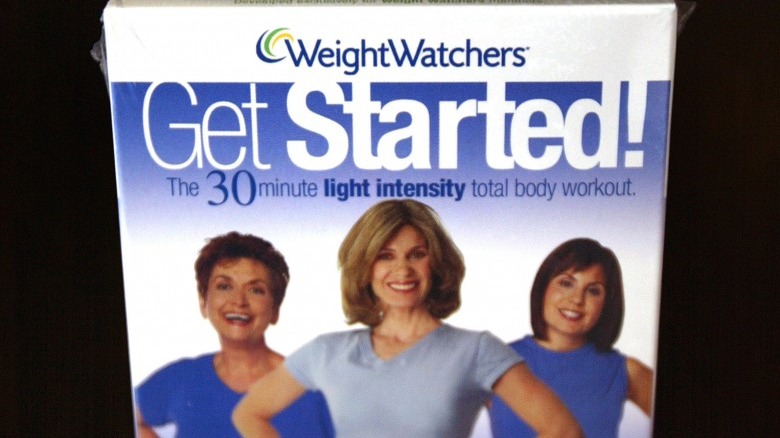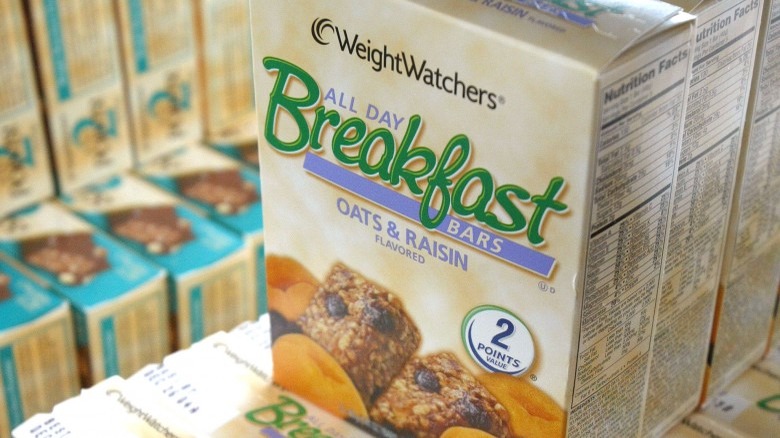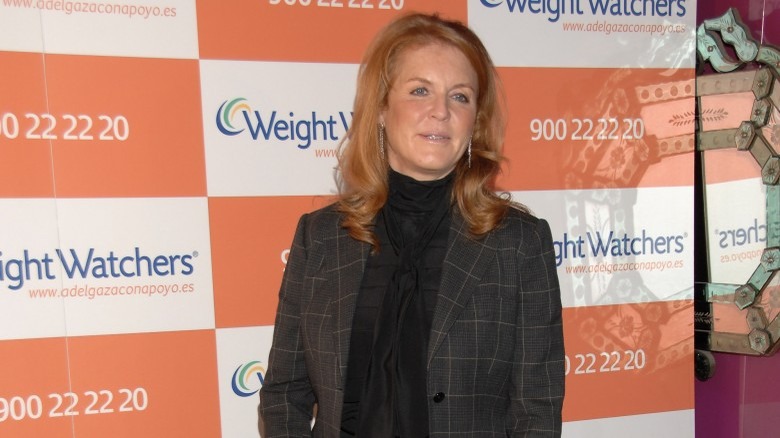The Untold Truth Of Weight Watchers
Weight Watchers is such a staple in the diet industry that it seems like it's always been around — yet this corporate giant evolved from very humble beginnings. Before you go back to counting your points, learn the untold truth of Weight Watchers.
It started with a housewife who had trouble with her weight
Weight Watchers didn't start with some big corporation trying to make women thin. It started with a housewife who needed help with her weight. Jean Nidetch, who was 37 in 1961, got asked a question all overweight women dread: "When are you due?" Since Nidetch was not with child at the time, she knew it was time to conquer her weight. According to The Dorito Effect, after Nidetch tried a variety of doctors and diet plans, she never found anything she could stick to. She even went to meetings where everyone followed a plan together, but after she kept surreptitiously eating cookies she kept hidden around the house, Nidetch couldn't face the group and continue to lie about the real reason she wasn't losing much weight.
Instead of giving up, Nidetch decided she needed to be honest. She invited over some friends who were also struggling with weight and divulged her cookie secret. It turns out, they all did the same thing! It wasn't cookies for everyone, but they all dealt with the secret shame of extra meals and snacks. The women felt so much better after the meeting, they asked Nidetch if they could come back next week. Eventually, Nidetch lost 72 pounds and made a business of her weekly meetings.
Within seven years, it was a national franchise
Nidetch kept up her weekly meetings, and they soon grew too big to have at her home. She was so inspired by working with others and finally defeating her cycle of gaining and losing, she wanted to make it her life's work to help others conquer their issues with food.
According to PBS, by 1963, she incorporated Weight Watchers and gave the group more structure. Now, each meeting had a specific meal plan, check-in meetings, and elected group leaders. Word of mouth fueled Weight Watchers' success, and by 1968, the brand was franchised nationally, according to PBS. The diet brand went public the same year and sold out immediately. Nidetch created a system known nationwide, and it kept on growing. For a business to go from a meeting in a housewife's den to a national franchise in seven years is amazing. The fact that it was lead by a woman in the '60s, a time not known for encouraging female entrepreneurs, makes the story even more incredible.
The diet wasn't always so flexible
Nowadays, Weight Watchers is known for its flexible points meal plan that promises you can still eat pizza and lose weight. But that's not how Nidetch started it. The first meal plan was much more strict, though it follows a pretty typical low calorie diet plan with lots of lean meats and vegetables. Hold the Toast once published the original diet plan from their copy of the 1966 Weight Watchers Cookbook. It included meals like a breakfast of one egg or one slice of toast and ¼ cup of cottage cheese, a lunch of four ounces of lean meat and ⅔ cup cottage cheese with unlimited vegetables, and a dinner of six ounces of lean meat with one serving of "limited vegetables." Throughout the day you had to eat three fruits, one being a grapefruit, and drink a cup of buttermilk or skim evaporated milk. I don't think we ever would have gotten excited Oprah commercials about this diet plan.
Before there were points, there was the 'Exchange Program'
After Nidetch's original diet plan, Weight Watchers evolved into a program that was a little more flexible. They still didn't work with points, but had an "exchange program." The wording of the diet is a little strange, but the plan was fairly simple. An "exchange" is just an odd way of saying a serving. You were allowed a certain amount of servings in each food group every day. The "exchange" comes in because you can exchange one food for any other in its same group. It followed the same kind of plan from the '60s, but now you could sub out your many servings of cottage cheese for something else in that same category.
In 1986, Nidetch published the Weight Watchers Quick Start Plus Program Cookbook. According to the Life After Low Carb blog, this plan still stuck with exchanges, but now you would start the first week of the program with a low calorie "Quick Start." Then the calories would increase gradually over a few weeks. Some people really miss these old Weight Watchers plans as compared to their modern points system.
The points system keeps changing
Weight Watchers has been around way longer than their main competition. Nutrisystem and Jenny Craig are the diet giant's longest lasting competition, as they were created in 1971 and 1983, respectively. One of the reasons Weight Watchers is still standing is it's always willing to change.
The "exchange" system was exchanged for the first iteration of points in in 1997. The new "1-2-3 Success Program" gave points to foods to help monitor intake of fiber, calories, and fat. According to Very Well, the diet plans evolved six times until they settled on the PointsPlus program in 2012. This diet offered more flexibility and gave you the chance to eat that piece of pizza or slice of cake when you really wanted it.
Still, Weight Watchers isn't done. In 2015, the company introduced the "Beyond the Scale" program, claiming this is the most personalized plan yet. It now incorporates fitness goals, links to fitness apps, and modern health and calorie calculations to make the plan better than ever. The company still use points to track food, but Weight Watchers is trying to make customers more active and further avoids sugars and saturated fats. Not all members are pleased with all the changes. The Washington Post documented tweets from unhappy customers who feel the new system is too restrictive and are disappointed they have to change from a diet plan that was really working for them. Most likely, that means another change will come to Weight Watchers in the next few years.
It has some scientific proof of working
The diet industry is gigantic, but of the many weight loss programs out there, only 11 have had scientific, randomized trials to see how well they work or if they work at all. This is insane! People are desperate to find an answer to obesity and going from diet to diet with no research to prove that any of them could help at all. No wonder the diet industry is so frustrating to those struggling with weight.
Fortunately, Weight Watchers has been scientifically studied and found effective. In 2011, a trial found that Weight Watchers was twice as effective as people trying to lose weight on their own. Now, this study was funded by Weight Watchers, so you should have a healthy dose of skepticism with those results. In 2015, Johns Hopkins reviewed more than 4,000 studies on different weight loss programs and found that Weight Watchers is one of the few that faced rigorous enough tests to prove its efficacy. Now, the results weren't huge. Johns Hopkins found that Weight Watchers participants lost three to five percent more than the control group. That doesn't equal great numbers, but at least there is some science to back up this diet industry giant.
Support from celebrities increases sales
Another reason for Weight Watchers' endurance as a titan of the diet industry is the company's use of celebrities to support the program. Over the years, many celebrity spokespeople have showed off their lean figures to help increase sales. Jennifer Hudson said she lost 80 pounds with Weight Watchers and was the main spokesperson for four years. Then Jessica Simpson reportedly lost over 50 pounds on the program, which she happily shared with the world in commercials for the company in 2014. Weight Watchers reached royalty when Sarah, Duchess of York became a spokesperson in 2008. The plan helped her slim down, but she's still struggled with her weight and recently lost another 50 pounds, though not on Weight Watchers.
The latest celeb face of the company, at the time of this writing, is by far the biggest of all. When Oprah Winfrey bought a part of Weight Watchers and became the spokesperson, investor stock prices jumped up 105 percent! Her commercial campaign and rabid fanbase have brought new excitement to the company and a lot of new customers.
Despite success stories, weight loss isn't easy
Weight Watchers touts success stories all over its ads and website, though if you look closely, you'll always see the "results not typical" asterisk in small print next to every smiling, newly thin face. Typically, people lose about 10 pounds a year. That's certainly better than nothing, but if you're expecting an over 50-pound transformation, you might get pretty disappointed. Plus, of those 10 pounds you lost, you'll probably gain back eight.
Though there has been a study that showed moderate weight loss results from Weight Watchers, that only measured patients for a year. Dishlab reviewed 60 years of diet studies and found that people typically lost about 10 percent of their weight in the first year, but gained back everything but two pounds in two to five years. Fully conquering obesity and your relationship with food is incredibly complicated. Weight Watchers' breezy commercials and fun apps make it all seem simple. Though it might be easy at first, to keep your results, it gets hard. Really hard. That's not to say Weight Watchers doesn't work. Lots of people have had success and truly love their system. It just isn't effortless.
You have to do it forever for it to work
One of the biggest reasons people regain weight, other than pregnancy or unexpected emotional or health issues, is that they stop following the program. Well, if someone stops doing the program, it's their own fault they gain the weight back, right? It isn't quite so simple. It's not that everyone on Weight Watchers who stops counting points immediately starts binging on full cakes. Members do the system for so long, they feel like they can watch their intake without writing down every single point. That seems pretty fair.
Kelly Burch shared her history with Weight Watchers with Prevention magazine. She recounted how she regained the 50 pounds she originally lost on the program. Burch did the system successfully, felt great, and was happy eating healthy, "But after three years I was utterly sick of writing down everything I ate or entering calories into an app. I just wanted to eat intuitively and to implement what I had learned without such a structured system. So I stopped tracking, and that's when the pounds started to creep back on," she wrote. This is a very typical story, not just with Weight Watchers, but with any calorie or food tracking diet.
Weight Watchers admittedly thrives on repeat customers. The BBC reported that Richard Samber, former financial manager of Weight Watchers, said, "[Weight Watchers] is successful because the other 84 percent have to come back and do it again. That's where your business comes from." If 84 percent of people can't keep weight off the second they stop counting points, that doesn't sound like a program that's teaching you lifetime habits. It just teaches you how to keep doing Weight Watchers.
Again, don't think that Weight Watchers is terrible or completely ineffective. You should just know that if you want real results from the program, you'll be counting points for the rest of your life. That's not necessarily a bad thing, but it's not what most people sign up for.
Weight Watchers' profits are following Oprah's weight
Weight Watchers has had its financial success ebb and flow over the years, but Oprah's recent involvement must mean its troubles are over. Again, stock prices jumped 105 percent from one word from the incredible female mogul. But it looks like Oprah has directly tied her own profits to her weight.
After that initial jump, stock prices returned to normal after Oprah's bread commercial and the company reported that they'd actually lost $11 million in that previous quarter. That didn't mean that Oprah's contributions were completely ineffective. The stock prices have drastically swung all year since then, but by the end of 2016, Weight Watchers reported a 10 percent increase in subscribers. As soon as Oprah released her newest campaign showing off her 40-pound weight loss, stock prices jumped again. Oprah herself made $10 million in less than a week from her slimmer figure.
It's great that Oprah is happy and losing weight, but it sounds like a pretty high pressure situation. Sure, if we got $10 million every time we lost weight, it would make us desperate to continue losing. But for Oprah, that's nothing. She probably gives Gayle $10 million-dollar presents just for being a cool friend. But knowing that a company you're invested in relies on your continued weight loss seems like a stressful situation. Would that mean that stocks could plummet if she gains five pounds? Even thinking about this makes me want to stress eat. Hopefully, Oprah is much stronger than me, though the company's current dependence on the Queen of Talk might not be quite the blessing it seemed.
Good intentions, questionable results
The story of Weight Watchers is a true inspiration. It made a mother and housewife a huge success in the business world in a time when that was almost unheard of for most women. The company has changed people's lives for the better and helped some conquer their battle with obesity. But it's not all easy, and Weight Watchers isn't as successful as it claims. It remains another tool in the war against weight that works for some and is just another failed diet plan for others.

